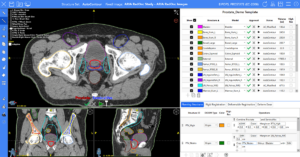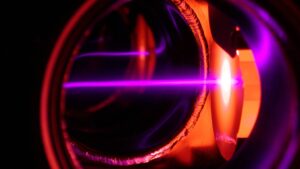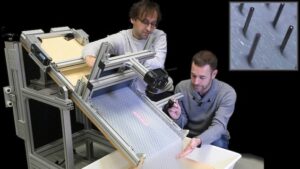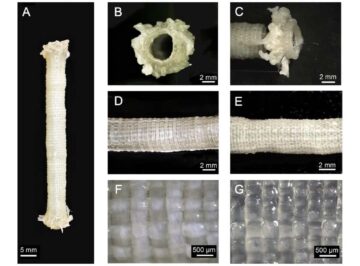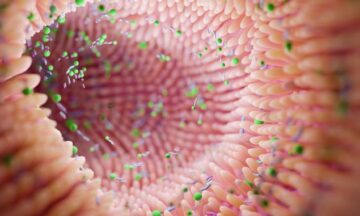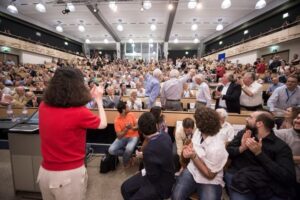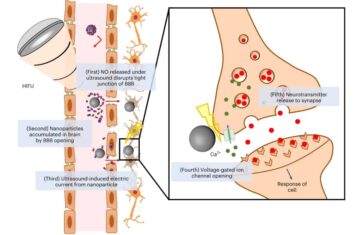The “P5” panel of US particle physicists says that work on developing a future muon collider could allow the US to regain the “energy frontier”, as Michael Allen reveals
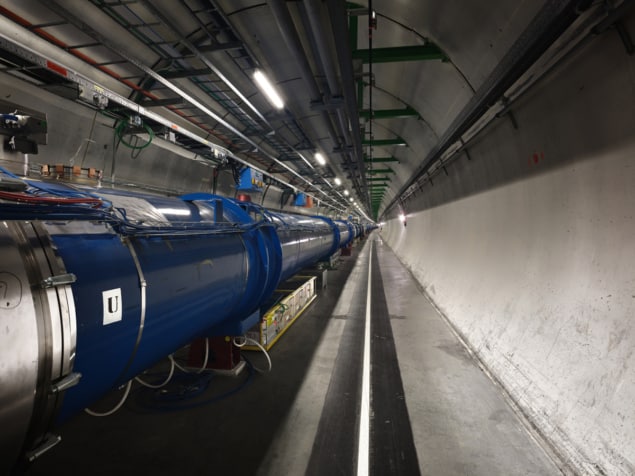
The US should explore building a muon collider and pursue “aggressive” research and development into the technologies required for such a facility. That is the conclusion of a high-profile committee of US and international particle physicists following a year of meetings to discuss the future of US high-energy physics research. The scientists acknowledge, however, that significant technical challenges would have to be overcome to build a muon collider.
The potential development of a muon facility is part of a long-term, 20-year vision for particle physics that was released in early December by the Particle Physics Project Prioritization Panel, or P5 (see box below). Since 2003 the P5 has met every decade to evaluate large- and medium-sized physics research projects. It then passes its recommendations to funding agencies such as the US Department of Energy (DOE) and the National Science Foundation.
Following the discovery of the Higgs boson in 2012 at CERN’s Large Hadron Collider, particle physicists began planning to build a so-called Higgs factory that would collide electrons with positrons to allow more detailed investigation of the properties of the Higgs boson and other particles. Some of these designs call for a 90 km-long tunnel that would first collide electrons with positrons in the mid-2040s before being repurposed later this century as a 100 TeV proton–proton machine to search for new physics.
Yet moving to these energies – and potentially even higher – is complicated. At energies approaching 1 TeV in a circular accelerator, electrons lose lots of energy through synchrotron radiation. This is not such a problem for protons, but reaching higher energies than 100 TeV requires an even larger ring than 90 km and would probably need new technologies too. One alternative option is to collide muons – cousins of electrons that are 200 times heavier. Given that muons are much heavier than electrons, energy loss would be less of an issue in a muon collider.
Daniel Schulte, study leader of the International Muon Collider Collaboration, who was not on the P5 committee, says that synchrotron radiation is “reduced by a factor of more than a billion” in a muon collider. “[Muons] are interesting because they could replace [electrons and positrons] directly and having a 10 TeV muon collider is roughly equivalent to having a 100 TeV proton collider in terms of physics reach,” says Schulte whose collaboration consists of more than 60 institutes, including CERN, that are drawing up a blueprint for an advanced muon facility. Any future muon facility could potentially be much more compact and perhaps cheaper to build – a muon collider with the same reach as a 100 TeV proton collider would fit on Fermilab’s existing site, for example.

CERN physicists meet in London to plot future collider plans
Referring to it as “our muon shot”, the P5 committee states that a muon accelerator programme would fit with the US’s ambition to host a major international collider facility, allowing it to lead global efforts to understand the fundamental nature of the universe. The P5 panel now recommends that the US builds major test and demonstrator facilities for such an advanced collider within the coming decade. The report also recommends that the US participate in the International Muon Collider Collaboration and “take a leading role in defining a reference design”.
Karsten Heeger, a physicist at Yale University who co-chairs the P5, told Physics World that the muon collider recommendation came from a desire to think about the long-term future of particle physics in the US, beyond the current crop of planned and developing projects. According to Heeger, this research and development recommendation has generated “a lot of excitement” in the US particle-physics community, particularly among younger scientists. “They feel that being able to pursue R&D to think about a future collider facility is really exciting, especially if we might be able to host it in the US,” he adds.
Challenges ahead
A muon collider, however, faces major technical challenges and it would be decades before any decision to build one could be made. One problem with muons is that they decay in barely 2.2 microseconds during which they would need to be captured, cooled and accelerated. “It is really pushing the technical frontiers in all elements,” says Heeger. “The magnet development, the acceleration technology, the beam focusing; all of these things are going to be critically important, and they have to be improved over where things are right now,” he adds.
Schulte agrees that if it were not for the muon’s limited lifetime, a muon collider would be “straight forward”. He says that one of the biggest challenges will be developing the required magnet technology. For instance, once the muons have been produced by proton collisions, high-temperature superconducting magnets will be needed to cool and slow them down. And this technology will need to be squeezed into a tiny space to reduce muon loss. High-speed magnets that can be cycled very fast will then be needed to accelerate the muon beam.

High-energy physics: are the days of international collaboration coming to an end?
The trouble is, much of this technology does not yet exist or is in its infancy. Despite these challenges, Heeger is confident a muon collider could be built: “Particle physicists and accelerator physicists have shown incredible ingenuity over recent years and decades, and so I am optimistic,” he says. But even if such a facility is not feasible, working towards it would build on current US strengths in particle physics and feed into improvements in proton and neutrino beam facilities. It would also likely have broad benefit to society including medical isotope production, materials science and nuclear physics, so Heeger believes it would be an “investment well spent”.
The development of high-temperature superconducting magnets, for example, would have important implications beyond particle physics. They could be useful for nuclear fusion reactors and may improve the performance of wind turbines. Schulte also believes that working towards a muon collider will offer substantial benefits when it comes to training the next generation of scientists. “This is a great project because things are new, there is room for inventions, for creativity, the spirit is very different from a project that is re-doing something that we did in the past in a bigger way,” he adds.
Plotting the future course of US particle physics
The P5’s report – Pathways to Innovation and Discovery in Particle Physics – builds on the output of a Snowmass conference, which gathered particle physicists and cosmologists from around the world in Seattle for 10 days in July 2022 to discuss research priorities and future experiments. The P5 report aims to create a research portfolio that studies nearly all the fundamental constituents of the universe and their interactions, covering both the cosmic past and future.
In terms of existing projects, the P5 committee’s top priority is the completion of the High-Luminosity upgrade at CERN’s Large Hadron Collider as well as the first phase of the Deep Underground Neutrino Experiment (DUNE) in Lead, South Dakota, which will study a high-energy beam of neutrinos produced at Fermilab as they travel 1280 km through the Earth. DUNE is due to begin operating around 2030. Other recommended priorities include Fermilab’s Proton Improvement Plan II and the Vera Rubin Observatory in Chile, which is expecting first light in 2025 and will conduct a 10-year survey of the southern sky.
Other recommendations include the CMB-S4 experiment – an array of ground-based telescopes, located at the South Pole and in the Chilean Atacama Desert that would observe the cosmic microwave background to probe the physical processes in the universe immediately after the Big Bang. The P5 also recommends that the US collaborates with international partners on a Higgs factory; a next-generation dark-matter direct-detection experiment; and the IceCube-Gen2 observatory, which will provide a 10-fold improvement in sensitivity to cosmic neutrinos over the current IceCube observatory at the South Pole.
“We tried to strike a balance between running the current programme, starting new projects and laying the groundwork in terms of R&D for the future,” says P5 co-chair Karsten Heeger. He adds that it was important to consider what comes after projects like the Higgs factory and completing DUNE for particle physics as well as for the next generation of scientists in the US. “If we fully focus right now just on executing the projects that are under way then we might find ourselves in 10–15 years not having laid the groundwork for what comes beyond,” he says.
- SEO Powered Content & PR Distribution. Get Amplified Today.
- PlatoData.Network Vertical Generative Ai. Empower Yourself. Access Here.
- PlatoAiStream. Web3 Intelligence. Knowledge Amplified. Access Here.
- PlatoESG. Carbon, CleanTech, Energy, Environment, Solar, Waste Management. Access Here.
- PlatoHealth. Biotech and Clinical Trials Intelligence. Access Here.
- Source: https://physicsworld.com/a/influential-us-particle-physics-panel-calls-for-muon-collider-development/
- :has
- :is
- :not
- :where
- $UP
- 1
- 10
- 100
- 150
- 200
- 2012
- 2022
- 2025
- 2030
- 60
- 90
- a
- Able
- About
- accelerate
- accelerated
- acceleration
- accelerator
- According
- acknowledge
- Adds
- advanced
- After
- agencies
- agrees
- aims
- All
- allow
- Allowing
- also
- alternative
- am
- ambition
- among
- an
- and
- any
- approaching
- ARE
- around
- Array
- artist
- AS
- At
- background
- Balance
- BE
- Beam
- because
- been
- before
- began
- begin
- being
- believes
- below
- benefit
- benefits
- between
- Beyond
- Big
- Big Bang
- bigger
- Biggest
- blueprint
- boson
- both
- Box
- broad
- build
- Building
- builds
- built
- but
- by
- call
- Calls
- came
- CAN
- captured
- Century
- CERN
- challenges
- cheaper
- Chile
- circular
- Co-Chair
- collaboration
- Collide
- comes
- coming
- committee
- community
- compact
- completing
- completion
- complicated
- conclusion
- Conduct
- Conference
- confident
- Consider
- consists
- Cool
- could
- course
- covering
- create
- creativity
- crop
- Current
- Dakota
- Days
- decade
- decades
- December
- decision
- defining
- Department
- Department of Energy
- Department Of Energy (DOE)
- DESERT
- desire
- Despite
- detailed
- developing
- Development
- DID
- different
- directly
- discovery
- discuss
- DOE
- does
- down
- drawing
- due
- Dune
- during
- Early
- earth
- efforts
- electrons
- elements
- end
- energy
- Equivalent
- especially
- evaluate
- Even
- Every
- example
- exciting
- executing
- exist
- existing
- expecting
- experiment
- experiments
- explore
- faces
- facilities
- Facility
- factor
- factory
- FAST
- feasible
- feel
- Find
- First
- fit
- Focus
- focusing
- following
- For
- Foundation
- from
- Frontiers
- fully
- fundamental
- funding
- fusion
- future
- gathered
- generated
- generation
- given
- Global
- going
- great
- groundwork
- Have
- having
- he
- high-profile
- higher
- host
- However
- HTTPS
- i
- if
- ii
- immediately
- implications
- important
- improve
- improved
- improvement
- improvements
- in
- include
- Including
- incredible
- Influential
- information
- ingenuity
- Innovation
- inside
- instance
- interactions
- interesting
- International
- into
- inventions
- investigation
- issue
- IT
- ITS
- jpg
- July
- just
- large
- larger
- later
- laying
- lead
- leader
- leading
- less
- lifetime
- light
- like
- likely
- Limited
- located
- London
- long-term
- lose
- loss
- Lot
- lots
- machine
- made
- Magnets
- major
- materials
- max-width
- May..
- medical
- Meet
- meetings
- met
- might
- more
- moving
- much
- National
- National Science
- Nature
- nearly
- Need
- needed
- neutrinos
- New
- New technologies
- next
- next-generation
- now
- nuclear
- Nuclear fusion
- Nuclear physics
- observatory
- observe
- of
- offer
- on
- once
- ONE
- operating
- Optimistic
- Option
- or
- Other
- ourselves
- outline
- output
- over
- Overcome
- panel
- part
- participate
- particle
- particularly
- partners
- passes
- past
- performance
- perhaps
- phase
- physical
- Physics
- Physics World
- plan
- planned
- planning
- plato
- Plato Data Intelligence
- PlatoData
- plot
- portfolio
- potential
- potentially
- prioritization
- priority
- probably
- probe
- Problem
- processes
- Produced
- Production
- programme
- project
- projects
- properties
- protons
- provide
- pursue
- Pushing
- R&D
- Radiation
- reach
- reaching
- really
- recent
- Recommendation
- recommendations
- recommended
- recommends
- reduce
- reference
- regain
- released
- replace
- report
- required
- requires
- research
- research and development
- right
- Ring
- Role
- Room
- roughly
- running
- s
- same
- says
- Science
- scientists
- Search
- Seattle
- see
- Sensitivity
- should
- shown
- significant
- since
- site
- sky
- slow
- So
- Society
- something
- South
- Southern
- Space
- spirit
- Starting
- States
- strengths
- strike
- studies
- Study
- substantial
- such
- Survey
- Technical
- Technologies
- Technology
- telescopes
- terms
- test
- than
- that
- The
- The Future
- The Projects
- the world
- their
- Them
- then
- There.
- These
- they
- things
- think
- this
- Through
- thumbnail
- times
- to
- told
- too
- top
- towards
- Training
- travel
- tried
- trouble
- true
- tunnel
- under
- understand
- Universe
- university
- upgrade
- us
- useful
- very
- vision
- was
- Way..
- we
- web
- WELL
- were
- What
- when
- which
- WHO
- whose
- will
- wind
- with
- within
- Work
- working
- world
- would
- year
- years
- yet
- Younger
- zephyrnet

